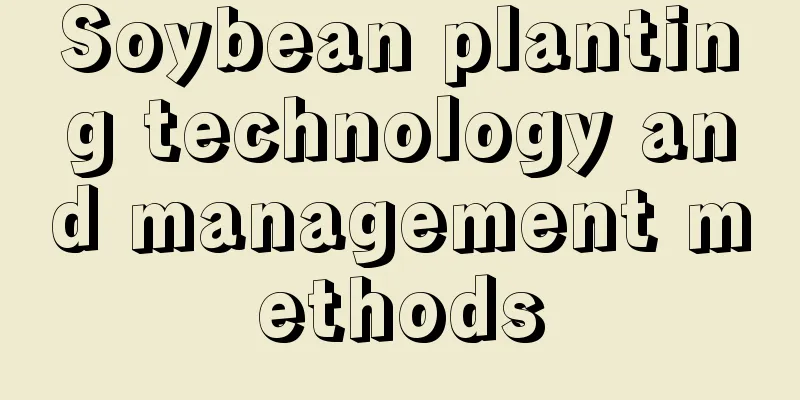Soybean planting technology and management methods

|
As an important oil crop in China, soybean is famous for its rich protein and fat content. As the concept of healthy eating becomes more and more popular, the market demand for soybeans continues to rise. The market price of soybeans has always been a focus of attention. Let’s learn about soybean planting techniques and management methods together. 1. Planting time and land preparation The soybean planting time depends on climatic conditions. For example, in some areas, spring sowing is carried out from April to May, and the harvest period is from late September to mid-October. The land needs to be cultivated before sowing. Ploughing can promote soil maturation and form a loose tillage layer 25 to 35 cm deep, which is conducive to nutrient absorption. Ridging after tillage helps to increase ground temperature and the depth of the tillage layer, and enhances soil drainage and drought resistance. For plots where the previous crop is corn, the stubble can be treated with a heavy plow before the early spring thaw, and then the ridges can be turned over and the seeds can be planted, and the ridges should be pressed down in time to prevent moisture loss. Deep tillage is a mechanized, diversified and promising farming method. 2. Seed selection and processing Choose high-quality soybean varieties with high germination rate and strong germination potential to ensure that the seedlings emerge evenly and thrive. Before sowing, diseased, insect-infested, small, barren and broken grains must be removed. Seed treatment involves the use of seed coating, a film-like substance containing insecticides , fungicides , microfertilizers and hormones. Seed coatings form a protective barrier in the soil to prevent pests and diseases, while slowly releasing active ingredients for 45 to 60 days to promote root growth. 3. Planting density It is crucial to reasonably determine the planting density of soybeans. Planting too densely will lead to a decrease in yield, while planting too sparsely will cause a waste of land resources and also affect yield. Therefore, the appropriate planting density should be determined according to the characteristics of the soybean variety and soil conditions to achieve the best yield. 4. Chemical weed control and fertilization When soil moisture is appropriate, soil sealing treatment can be performed, and post-emergence weeding is recommended for spring sowing in arid areas. The closed treatment is carried out 5 to 7 days after sowing and before emergence. When soybean seedlings emerge, shallow tillage should be carried out in time to a depth of about 1 cm. When the compound leaves unfold, deep tillage should be carried out to a depth of about 25 cm. When the plant height is 25 to 30 cm, the second tillage should be carried out with a depth of 8 to 12 cm. Complete the final trepanation before closing the ridges, with the same depth. Post-emergence weeding: Use soybean field-specific herbicides when the weeds are in the 2 to 4 leaf stage. Fertilization aims to supplement the nitrogen, phosphorus, potassium and other elements needed for soybean growth, promote growth and increase yield. The amount of fertilizer applied must be scientific and reasonable to avoid excessive fertilizer application that causes soil and water pollution, or insufficient fertilizer application that causes soybean chlorosis and disease, affecting yield. The depth of fertilization should be deep to stabilize the root system and promote nutrient absorption. 5. Pest and disease control Soybean diseases and insect pests seriously affect soybean quality and commercial grade. Pesticide weed control and insect control are common ways to prevent pests and diseases. According to the soybean growth conditions and insect forecast, timely disease and pest control is carried out to ensure soybean yield and healthy growth. To prevent soybeans from growing too tall, spray 15% paclobutrazol solution or pinch off the top during the flowering period. Timely harvesting is carried out when the leaves have fallen and the beans are mature, using mechanical combined harvesting, with a stubble height of 4 to 5 cm. The harvesting loss rate is controlled to be less than 1%, the threshing loss rate is less than 2%, the breakage rate is less than 5%, the mud stain rate is less than 5%, and the cleaning rate is greater than 95%. In short, increasing soybean yields requires taking appropriate management measures based on local growing conditions. Scientific planting methods and field management techniques are the key to ensuring good soybean returns. Through careful management, soybean growers can effectively increase yields and economic benefits.
|
<<: What should I do if my red-eared slider turtle doesn’t eat?
>>: What should I do if the leaves of the flowers turn yellow?
Recommend
Disease and insect pest control of Belamcanda chinensis
Diseases There are two most common diseases among...
How to raise little red clothes
1. Maintenance methods 1. Temperature: Little Red...
Is azalea poisonous?
1. Some are toxic There are many varieties of aza...
Can lychees be grown in the north?
Can lychees be grown in the north? Lychees can be...
How often should I water the flower?
How often should I water the flower? Generally, t...
These 5 fruits are best grown in pots
strawberry Many people like to grow strawberries ...
Can jasmine be rooted in water?
1. Is it possible? Jasmine can be rooted in hydro...
How to spray water for indoor flowers
Common indoor foliage plants spray asparagus Cult...
How often should I water the small-leaved red cypress?
How often should I water the small-leaved red cyp...
Which succulent plants can survive freezing at minus ten degrees? Which succulent plants are not afraid of freezing and are easy to grow?
In winter, most succulents are difficult to grow,...
How to save asparagus fern from root rot
1. Reduce watering Reason: If you water asparagus...
How to collect seeds and overwinter Begonia
Harvesting Methods of Begonia Varieties The main ...
The reproduction method of red scale syzygium
Reproduction method There are three ways of repro...
Cultivation method of golden leaf pine
1. Soil Golden pine prefers well-drained, fertile...
African Impatiens cultivation methods and precautions
1. Suitable temperature African Impatiens has rel...









